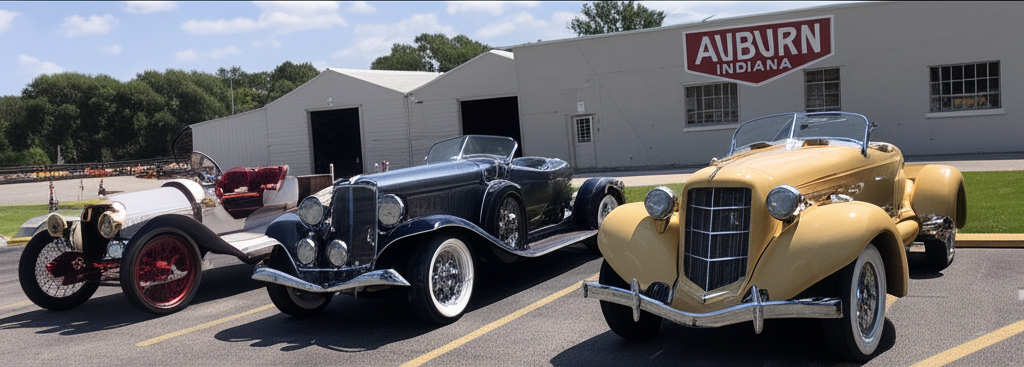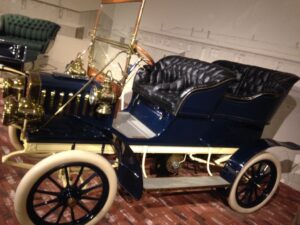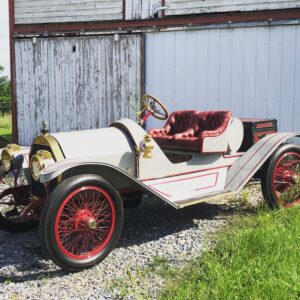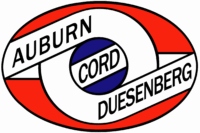
History of the Auburn

 Established in 1903 by Frank and Morris Eckhart, with the patronage of their father Charles Eckhart, the Auburn Automobile Company (AAC) produced some of the most-desirable, aesthetically striking and technologically innovative automobiles.
Established in 1903 by Frank and Morris Eckhart, with the patronage of their father Charles Eckhart, the Auburn Automobile Company (AAC) produced some of the most-desirable, aesthetically striking and technologically innovative automobiles.
From its humble beginnings in the corner of the Eckhart Carriage Company factory, Frank and Morris grew the AAC to occupy its own dedicated facility in 1909. Headquartered in Auburn, Indiana, a town of 5,000 people, the company successfully built a reputable automobile that sold nationwide.
In 1924, Errett Lobban Cord became general manager and would save the AAC from an early death. Hired by a group of investors from Chicago who bought the AAC from the Eckhart family in 1919, Cord grew the reputation of Auburn automobiles worldwide. The consummate marketer, Cord knew how to promote racing prowess and in-vogue style, making these attributes synonymous with Auburn to this very day.
Engineers such as James Crawford, Herbert Snow, George Kublin and Cornelius Van Ranst pushed the limits of technical innovation. Alan Leamy and Gordon Buehrig’s magnificent body designs earned Auburns accolades for style worldwide.
The journey ended in 1937 with AAC’s bankruptcy. E. L. Cord sold the company to AVCO and then headed out west to create new fortunes. Like a dying star, AAC burned the brightest just before its death, with their automobiles earning many speed and endurance records. Even today, Auburns are still revered for their elegance and performance.
Generations of the Auburn Automobile
1903 – 1918 – In The Beginning
Like many early automobile makers, the AAC began as an assembled vehicle with various components sourced from many suppliers. Having been an outgrowth of the Eckhart Carriage Company, the AAC had a ready source of craftsmen to construct bodies for the fledgling company.
The Auburn went from a horseless carriage, with an engine situated under the body, to a conventional automobile with the engine in front of the passenger compartment. Auburn’s made a giant leap from a two-cylinder engine to the massive six-cylinder engine. In 1918, the Eckhart family made the decision to exit the automobile business, selling to a group of investors, whom Auburn locals referred to as the ‘Chicago Gang’.
1919 – 1924 – The Competition Grows
It was the Beauty-Six line, introduced just before the Echkart family divested ownership, that grew AACs national presence and proved a small company could develop styling on par with larger automobile makers. The Beauty-Six used the same chassis as the previous Auburn models, but its more chiseled body styling and integrated radiator shell gave it a contemporary and sporting look.
During this period the automotive industry drastically changed. Many small auto makers disappeared and the playing field with larger manufacturers became fierce. The AAC continued to introduce new models with both open and closed bodies. Even with the optional Weidely overhead-valve engine, an uncommon design in its day, AAC struggled to stand out among the hundreds of automobile makers.
1925 – 1930 – A New Beginning
With E. L. Cord’s arrival, AAC would be changed forever. With the new second-series 1925 models, the Auburn expressed distinct styling. It was James Crawford, AAC’s chief engineer that made E. L. Cord’s dream car a reality. This included the rounded radiator shell and the signature “streamer” body modeling which began at the top of the radiator and flowed down each side of the hood and then along the side of the body.
An eight-cylinder engine provided both the prestige and performance E. L. Cord desired to sell the Auburn. In 1928, hydraulic brakes and the sensational Speedster model were introduced, winning accolades and racing trophies the world over. In 1929, the AAC began automobile production in Connersville, Indiana, with the anticipation of expansion. E. L. Cord was ready to take the Auburn automobile to new heights.
1931 – 1933 – Triumph and Decline
The AAC knew it was time for a fresh look and incorporation of the latest automotive innovations. Flush with the financial success of the previous five years, the AAC developed its first all-new automobile since its founding. The talented stylist Alan Leamy penned the exterior with flowing lines and a low-silhouette. Herbert Snow, vice-president of engineering, incorporated the company’s patented X-member into the Auburn frame creating a stiffer chassis than its competitors.
In 1931, the AAC had its greatest sales year with a profit of $4.1 million and production of nearly 33,000 Auburn automobiles. The triumph was short-lived, and as the Great Depression lingered, sales fell. The AAC continued to introduce new trim lines, such as the Salon, with updated styling and increased use of chrome. It also offered the lowest priced V-12 engine in the United States and continually improved its automobile’s performance.
By 1933, the AAC knew it had to make a drastic change in its automobiles to be competitive.
1934 – 1936 – A Bright Star Fades
This period was the last complete restyle of the Auburn automobile. AAC transitioned to a nearly all-steel body, removing wood as a structural support. It also reintroduced the six-cylinder engine, absent since the end of the 1930 model year. The radical styling change by Alan Leamy provided the Auburn with an art-deco flavor. The AAC made a large investment into the nearly all-new Auburn, a cost it could little afford. Sales increased over the previous year but not enough to make the company profitable.
With internal strife and external market pressures, the AAC performed a face-lift of the new Auburn in 1935, styled by Gordon Buehrig. The performance option of a supercharger was also added and the Auburn continued to break endurance and speed records. The AAC also tried to enter the commercial automobile market with a line of ambulance and hearse models. Unfortunately, it was all for naught, in 1937 AAC declared bankruptcy and passed into the annals of automotive history.
